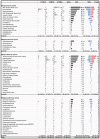Insights into the Distribution Patterns of Foot and Ankle Tumours: Update on the Perspective of a University Tumour Institute
- PMID: 38256484
- PMCID: PMC10815983
- DOI: 10.3390/jcm13020350
Insights into the Distribution Patterns of Foot and Ankle Tumours: Update on the Perspective of a University Tumour Institute
Abstract
The rarity of foot and ankle tumours, together with the numerous histological entities, presents a challenge in accumulating sufficient patients to draw reliable conclusions. Therefore, we decided to present an update of a retrospective analysis of their distribution patterns, comprising 536 cases of foot and ankle tumours presented to our tumour board between June 1997 and June 2023. Our aim was to provide a comprehensive overview of the prevalence and distribution patterns of benign and malignant bone and soft tissue tumours of the foot and ankle. A total of 277 tumours involved bone (51.7%). Of these, 242 (87.4%) were benign and 35 (12.6%) were malignant. In addition, 259 soft tissue tumours (48.3%) were found, of which 191 (73.7%) were benign and 68 (26.3%) were malignant. The most common benign bone tumours were simple bone cysts, enchondromas, osteochondromas, aneurysmal bone cysts, and lipomas of bone. Common benign soft tissue tumours included a tenosynovial giant cell tumour, haemangioma, plantar fibromatosis, schwannoma, and lipoma. The most common malignant soft tissue tumours were synovial sarcoma, malignant melanoma, and myxofibrosarcoma. In terms of anatomical location, the hindfoot was the most common site (28.7%), followed by the midfoot (25.9%), ankle (25.4%), and forefoot (20.0%). The distribution of benign entities often follows typical patterns, which may facilitate an early diagnosis even without biopsy (e.g., simple bone cyst, plantar fibromatosis). On the other hand, the distribution patterns of many rare or malignant entities are inconsistent. Individual soft tissue malignancies occur very sporadically, even over long periods of time and in specialized tumour centres. It is therefore important to recognise that any suspicious mass in the foot and ankle must be considered a possible malignancy until proven otherwise.
Keywords: bone sarcoma; distribution pattern; foot tumour; musculoskeletal tumour; soft tissue sarcoma.
Conflict of interest statement
The authors declare no conflicts of interest.
Figures
References
LinkOut - more resources
Full Text Sources



